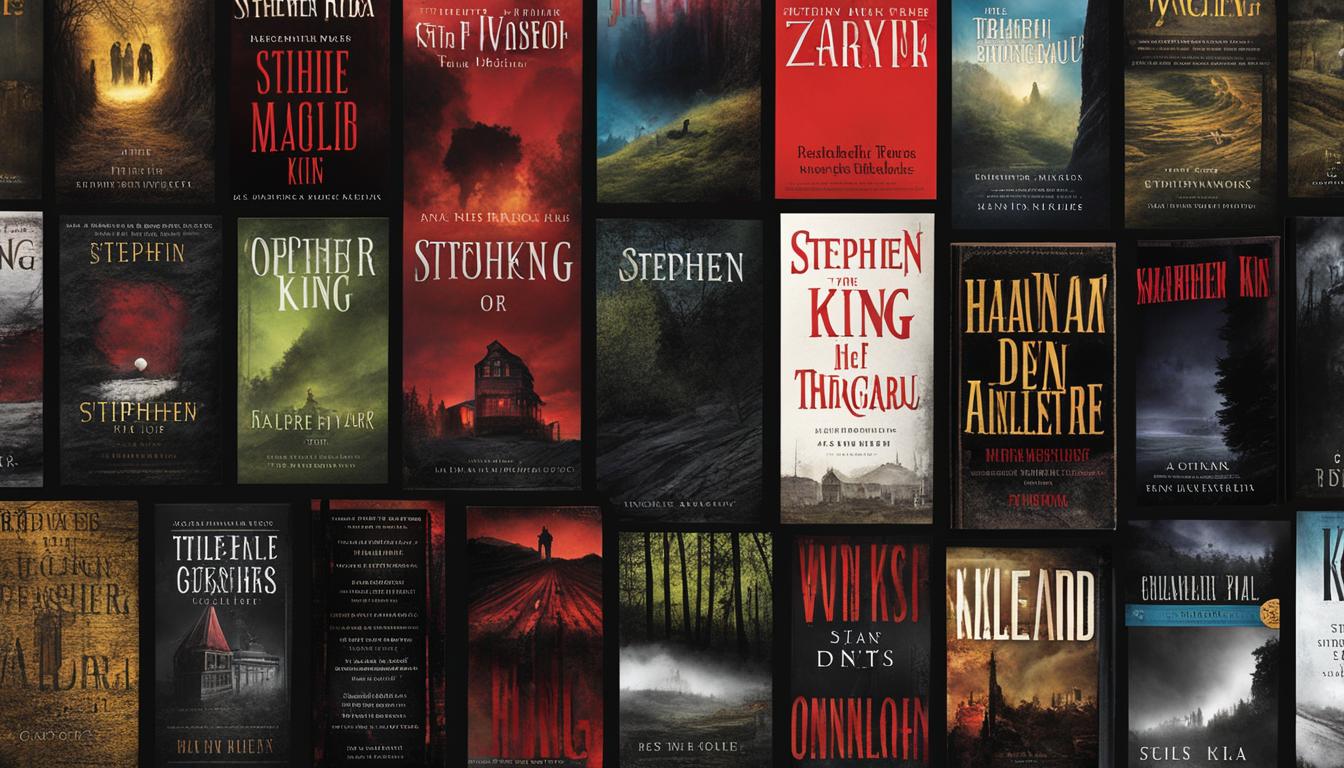If you’re a fan of horror literature, you’ve likely heard of Stephen King. With dozens of books and countless short stories under his belt, he has solidified his place as one of the most prominent authors in the genre. In this guide, we’ll take a closer look at King’s works, from his most renowned novels to some lesser-known gems. We’ll also explore the themes and motifs that run throughout his stories, his influence on pop culture, and his impact on contemporary horror authors. Whether you’re a seasoned fan or a newcomer to King’s literary universe, this guide has something for everyone.
Introduction to Stephen King
Stephen King is a name synonymous with horror novels, with a career spanning over five decades. Born in Portland, Maine, in 1947, he credits his early interest in writing to his mother and an uncanny fascination with horror films.
King’s love for horror fiction cemented after reading H.P Lovecraft’s “The Lurking Fear,” and ‘The Thing From Another World’ comic book series at the age of 12. From then on, he devoted his time to writing and submitted his stories to publishing companies.
Despite facing numerous rejections, King’s debut novel “Carrie” was published in 1974, becoming a massive success, leading to his notable reputation among horror fans.
“I recognize terror as the finest emotion, and so I will try to terrorize the reader. But if I find that I cannot terrify, I will try to horrify, and if I find that I cannot horrify, I’ll go for the gross-out. I’m not proud.” – Stephen King (Danse Macabre)
Throughout his career, King has authored more than 60 books, seven of which have been adapted into motion pictures, with numerous others being converted into miniseries and television productions.
From psychological thrillers to supernatural horror, King’s books have captivated readers worldwide. In the next section, we explore some of his notable works and delve into their themes and plotlines.
Iconic Stephen King Novels
Stephen King’s novels are some of the most popular books in the horror genre, captivating readers with their vivid imagery, intricate plots, and compelling characters. Here are some of his most iconic novels:
| Novel | Publication Year | Plot Description |
|---|---|---|
| Carrie | 1974 | A young girl with telekinetic powers and an abusive mother finally snaps after being pushed too far. |
| The Shining | 1977 | A recovering alcoholic takes a job as a caretaker of a secluded hotel, where he discovers the hotel’s dark past and his own descent into madness. |
| It | 1986 | A group of childhood friends reunite as adults to face their darkest fears in the form of an ancient, malevolent being in their small town. |
These Stephen King novels have had a tremendous impact on the horror genre, inspiring countless adaptations in film and television. Their themes of fear, loss, and the supernatural continue to resonate with audiences today.
Stephen King’s Short Story Collections
Stephen King is well-known for his novels, but his short stories are a fantastic showcase of his writing talent too. He has compiled collections of these stories over the years for readers to indulge in. Here, we’re exploring a few of his most well-known short story collections, each with their own unique themes and tales to tell.
Night Shift

First published in 1978, Night Shift is one of Stephen King’s most famous short story collections. It includes a range of stories from “Children of the Corn” to “The Lawnmower Man” and “The Boogeyman.” The tales are largely horror-themed and kept readers on the edge of their seats.
| Short Story | Description |
|---|---|
| The Mangler | A story about a possessed industrial laundry press |
| Battleground | A story about a hitman and his war with toy soldiers |
| Quitters, Inc. | A chilling tale that explores smoking addiction |
Skeleton Crew

Skeleton Crew is a collection of short stories published in 1985. This book features some of King’s most memorable tales like “The Mist,” and “Survivor Type.”
| Short Story | Description |
|---|---|
| The Mist | A story about a creature-filled mist enveloping a town |
| The Jaunt | A twisted sci-fi tale |
| The Monkey | A horror story about life-sized monkey toys |
Just After Sunset

Just After Sunset, published in 2008, is another collection of short stories by the master of horror. This collection includes a variety of tales from “Willa,” a story about a ghost haunting a former writer, to “Rainy Season,” a supernatural tale about a couple’s journey to a small town.
| Short Story | Description |
|---|---|
| The Gingerbread Girl | A psychological thriller following the protagonist’s escape to a remote island |
| N. | A supernatural story about a cursed New England field |
| Graduation Afternoon | A horror story about a group of students at an isolated pool |
These collections of Stephen King’s short stories offer an excellent opportunity for readers to experience his tales, even when they’re short on time. Each story is unique in its own way, and the collections build to be complete and entertaining reads for any fan of the horror genre.
Themes and Motifs in Stephen King’s Works
Stephen King has created a diverse range of stories, but his works contain several recurring themes and motifs that add to their eerie atmosphere and leave a lasting impression on the reader. The following are some of the common threads:
- The Supernatural: King’s works often explore the supernatural and the unknown, with ghosts, monsters, and otherworldly creatures making appearances throughout his stories. They often serve as a metaphor for the darker aspects of the human experience and our own inner demons.
- Small-Town Settings: Many of King’s stories take place in small towns, creating a sense of closeness and community but also highlighting the potential for evil and darkness to lurk beneath the surface.
- The Power of Fear: Fear is a prevalent theme in many of King’s works, both as something to be feared and as a means of overcoming adversity. Characters often face their fears head-on, whether it’s a supernatural entity or a personal struggle.
- Violence and Trauma: King’s stories often feature violence and trauma, exploring the psychological effects of such experiences on his characters. This includes themes of abuse, loss, and addiction, highlighting the darker aspects of the human psyche.
Overall, King’s works cultivate a feeling of dread and unease, making them stand out in the horror genre. By exploring these recurrent themes and motifs, we can gain a deeper insight into the complex and chilling world of Stephen King’s stories.
Stephen King’s Impact on Pop Culture
In addition to captivating readers with his chilling horror stories, Stephen King has also left an indelible mark on pop culture.
His extensive body of work has been adapted into numerous films and television shows, further solidifying his place in popular culture. In fact, King is one of the most adapted authors of all time, with over 100 film and TV adaptations of his works.
Some of the most iconic adaptations include The Shining, Carrie, and It, which have become staples in horror cinema. However, adaptations of King’s work have also extended beyond the horror genre, with films such as The Shawshank Redemption and The Green Mile showcasing King’s versatility as a writer.
King’s influence in pop culture has also extended to other media, such as music and video games. Various musicians, including Eminem and Blue Öyster Cult, have referenced King’s works in their music, and video games such as The Dark Pictures Anthology: Man of Medan have drawn inspiration from his storytelling techniques.
Overall, Stephen King’s impact on pop culture is immeasurable, with his influence spanning across various forms of media and genres.
Lesser-Known Stephen King Gems
Stephen King’s literary universe goes beyond his popular works, with several lesser-known books that are equally captivating. These hidden gems showcase King’s mastery of the horror genre and unique storytelling capabilities. Below, we explore some of these lesser-known books and their unique qualities that make them worth the read.
The Long Walk
The Long Walk follows the journey of 100 teenage boys on a walking contest that pushes them to their physical and mental limits, with the ultimate prize being unlimited riches. This haunting tale explores themes of endurance, morality, and the lengths people will go to survive.
The Girl Who Loved Tom Gordon
In this suspenseful novel, a 9-year-old girl gets lost in the woods during a family camping trip. As she navigates through the wilderness, she seeks comfort and guidance from her favorite baseball player, Tom Gordon, who comes to life in her imagination. The Girl Who Loved Tom Gordon explores the power of the human mind and the strength to survive in dire circumstances.
| Book Title | Publication Year | Genre |
|---|---|---|
| The Long Walk | 1979 | Horror |
| The Girl Who Loved Tom Gordon | 1999 | Horror |
The Eyes of the Dragon
The Eyes of the Dragon is a fantasy novel set in the mystical realm of Delain, following the story of Prince Peter and his treacherous journey to the throne. This book showcases King’s versatility as a writer, with a departure from his usual horror themes and an engaging plot filled with magic, intrigue, and suspense.
These lesser-known Stephen King books prove that his writing prowess goes beyond his popular works. Each book brings unique qualities, from walking contests to magical realms and haunted towers, to keep readers captivated and on the edge of their seats.
Evolution of Stephen King’s Writing Style
Stephen King’s writing style has undergone significant changes throughout his prolific career. From his early works to his recent publications, his unique storytelling techniques have captivated readers and catapulted his books to the top of bestseller lists.
One of the notable changes in King’s writing style is his shift from horror to suspense, evident in books like “Misery” and “The Green Mile.” He also employs a more character-driven approach to storytelling, focusing on the inner workings of his protagonists and the intricacies of their relationships.
King’s narrative structure has also evolved, with his more recent works featuring non-linear timelines and multiple points of view. This allows him to explore complex themes and motivations in a more nuanced way, creating a richer and more immersive reading experience.
Another aspect of King’s literary development is his use of literary techniques. In “On Writing,” King reveals that he enjoys experimenting with language and syntax, and that his writing is heavily influenced by literary greats such as William Faulkner and Ernest Hemingway. This brings a heightened level of literary sophistication to his work.
Impact on His Works
King’s evolving writing style has influenced the tone and atmosphere of his books, transforming them from straight-up horror to more nuanced explorations of the human psyche. His focus on character development and narrative structure has also elevated his works, giving readers a more comprehensive and engaging reading experience.
Stephen King’s Influence on Contemporary Horror Authors
Stephen King’s impact on the horror genre extends far beyond his own work. His writing style, unique themes, and innovative storytelling have inspired many contemporary horror authors.
One example is Joe Hill, King’s son and a successful horror author in his own right. Hill’s debut novel, “Heart-Shaped Box,” was published in 2007 and garnered critical acclaim for its masterful storytelling and taut suspense, reminiscent of his father’s work.
Another author influenced by King is Paul Tremblay, whose novel “A Head Full of Ghosts” won the prestigious Bram Stoker Award in 2015. Tremblay has cited King as a significant influence, and his work often features similar themes of supernatural horror and small-town settings.
Kaitlyn Sage Patterson, author of “The Diminished,” has also acknowledged King’s influence, stating that his work inspired her to pursue a career in writing and to craft gripping, suspenseful tales that keep readers on the edge of their seats.
“I was always attracted to stories with dark, eerie elements, and Stephen King’s works showed me what was possible in terms of crafting a chilling, immersive story,” says Patterson.

Exploring Stephen King’s Extended Universe
Stephen King’s literary universe is more than just a collection of books and short stories. He often incorporates interconnected elements within his works, creating a shared universe that intertwines his stories and characters. For instance, the character of Randall Flagg appears in several of King’s works, including “The Stand” and “The Dark Tower” series. This shared universe adds depth and complexity to King’s storytelling and keeps readers coming back for more.
King’s interconnected stories can be subtle or overt, with characters appearing briefly or more prominently in different works. For example, stories from his short story collection “Different Seasons” are interconnected through themes and settings, while “Desperation” ties directly into the plot of “The Regulators.”
The Stephen King shared universe is a testament to his masterful storytelling abilities and attention to detail. By creating connections between his works, he has established a rich and expansive world that spans beyond individual books. This shared universe not only adds to the reading experience but also underscores King’s impressive literary prowess.
Interconnected Elements in Stephen King’s Writing
| Work | Interconnected Element |
|---|---|
| The Dark Tower Series | Connects to several other King works and features characters from other stories |
| The Stand | Features Randall Flagg as a primary antagonist, who also appears in other stories |
| Different Seasons | Interconnected through themes and settings |
| Desperation | Ties directly into the plot of “The Regulators” |
As can be seen in the table above, Stephen King’s interconnected elements in his writing are diverse, ranging from recurring characters to thematic ties and direct plot connections. This level of detail and consistency is a hallmark of King’s works and contributes to the eerie and captivating universe he has created.
The interconnected universe of Stephen King’s writing is a fascinating and intricate world, one that is always evolving and expanding. With every new book and short story, readers are given more clues and insights into this complex universe, making it an exciting and engaging reading experience.
Conclusion
In conclusion, Stephen King’s contribution to the horror genre is unparalleled. His vast collection of books and short stories has captured the imaginations of readers worldwide, solidifying his position as a master storyteller. Through this comprehensive guide, we have explored his life, iconic novels, short story collections, themes, and impact on pop culture.
King’s writing style has evolved over the years, yet his ability to create compelling characters and weave intricate plots remains a hallmark of his work. His influence extends beyond his own books, inspiring and shaping a new generation of horror authors.
As we’ve seen, Stephen King’s works continue to terrify and captivate readers, proving his enduring impact on the horror genre. Whether you’re a die-hard fan or a curious newcomer, there’s no denying that Stephen King is a literary force to be reckoned with.



